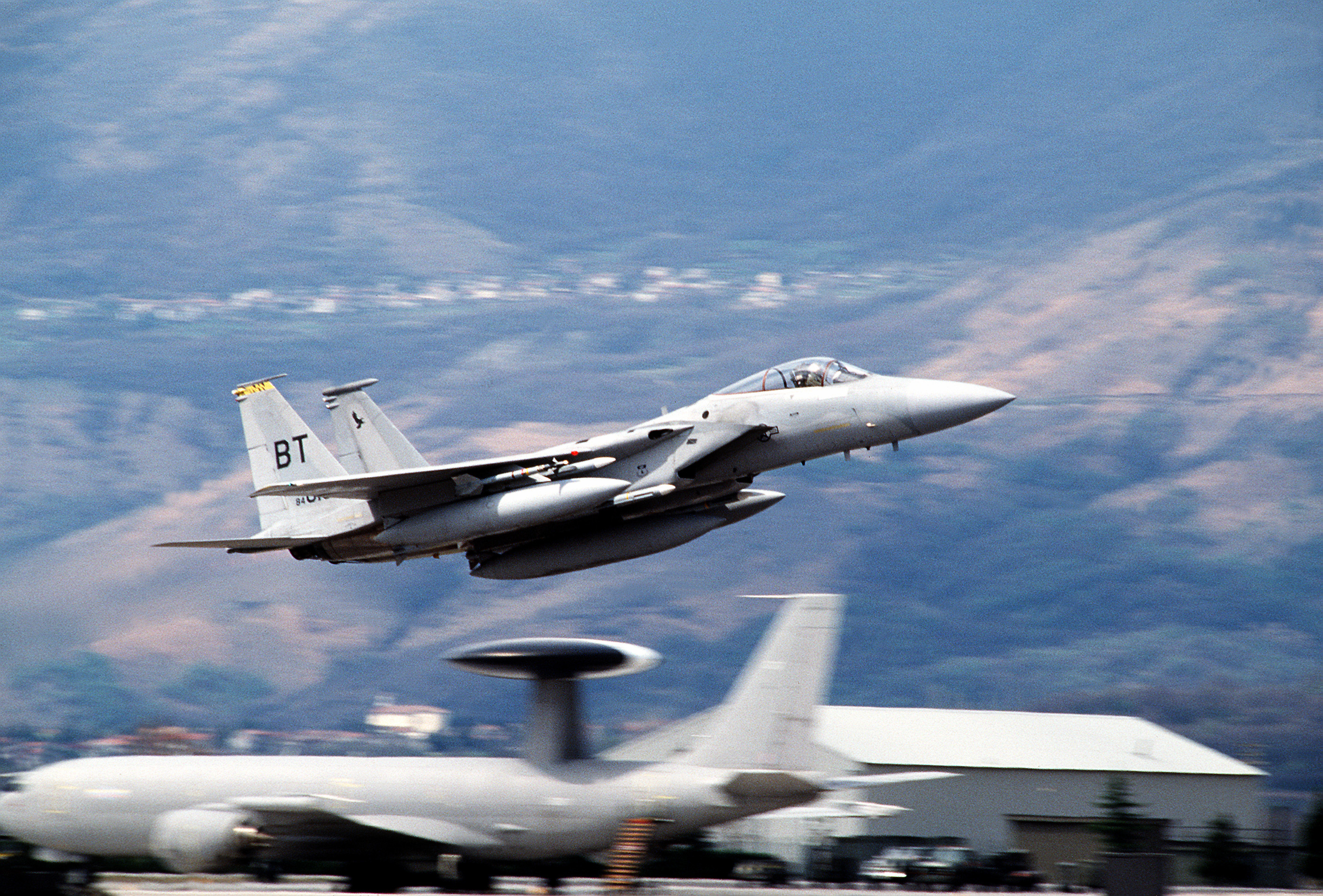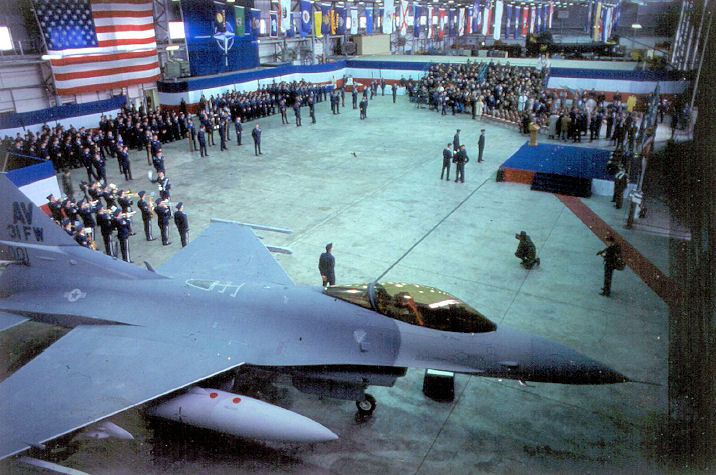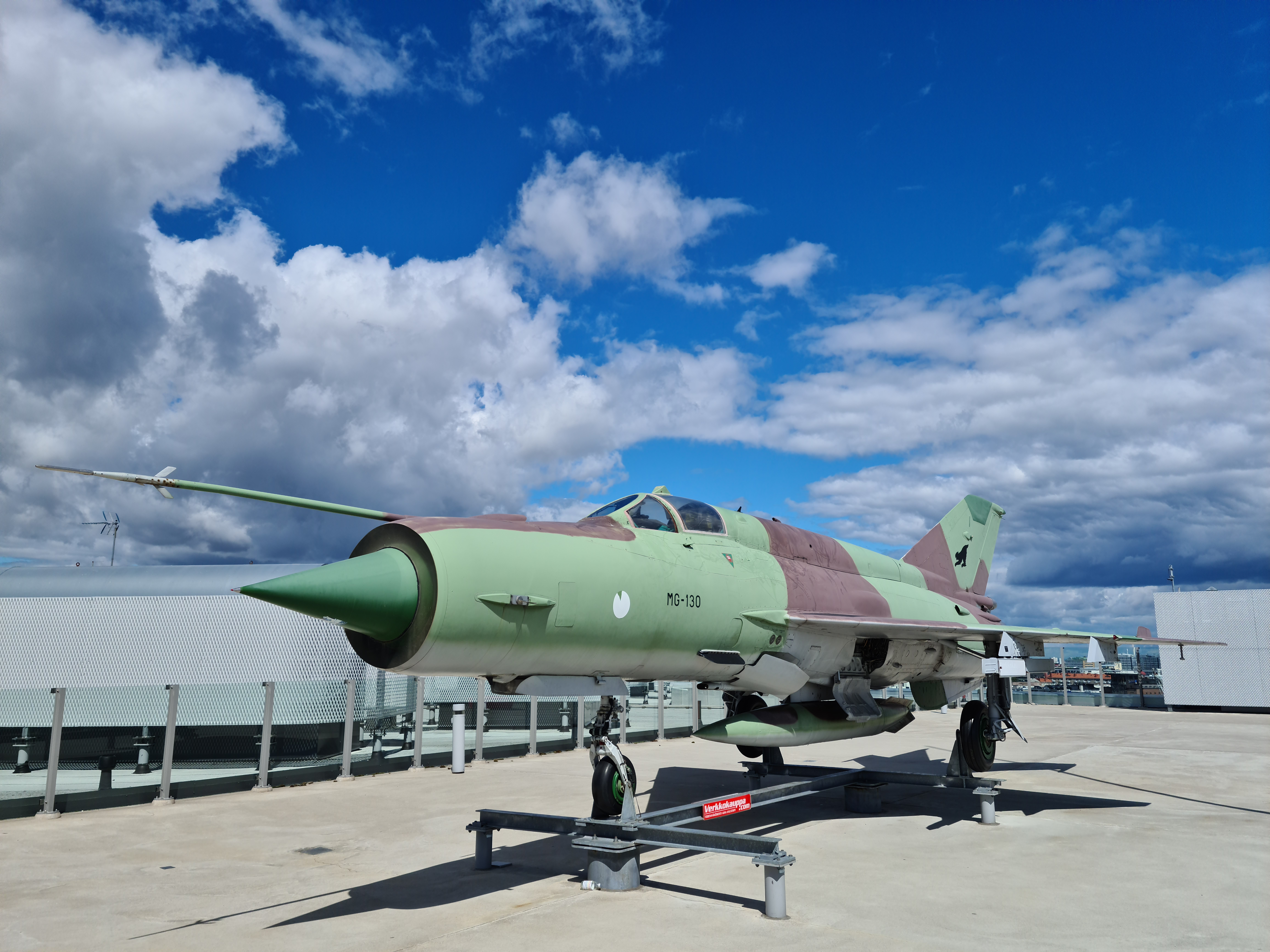|
Operation Sky Monitor
Operation Sky Monitor was a NATO mission to monitor unauthorized flights in the airspace of Bosnia and Herzegovina during the Bosnian War. The operation began in response to United Nations Security Council Resolution 781, which established a ban on the use of military aircraft in Bosnian airspace, and requested the aid of member states in monitoring compliance. Beginning on October 16, 1992, NATO monitored violations of the no-fly zone using E-3 Sentry NAEW aircraft based in Germany, Italy, Greece, and the United Kingdom. The operation documented more than 500 violations of the no-fly zone by April 1993. In response to this high volume of unauthorized flights, the Security Council passed Resolution 816, which authorized NATO to enforce the no-fly zone, and engage violators. In response, NATO deactivated Sky Monitor on April 12, 1993, transferring its forces to the newly established Operation Deny Flight. Background On September 25, 1991, at the beginning of the Yugoslav wa ... [...More Info...] [...Related Items...] OR: [Wikipedia] [Google] [Baidu] |
NATO Intervention In Bosnia
The NATO intervention in Bosnia and Herzegovina was a series of actions undertaken by NATO whose stated aim was to establish long-term peace during and after the Bosnian War. NATO's intervention began as largely political and symbolic, but gradually expanded to include large-scale air operations and the deployment of approximately 60,000 soldiers of the Implementation Force. At the same time, a large UN peacekeeping force, the United Nations Protection Force (UNPROFOR), made mostly of NATO countries troops, was deployed to Bosnia and Herzegovina from 1992 to 1995. A Rapid Reaction Force (RRF), also under UN mandate, was established around Sarajevo during the later stages of the conflict. Early involvement and monitoring NATO involvement in the Bosnian War and the Yugoslav Wars in general began in February 1992, when the alliance issued a statement urging all the belligerents in the conflict to allow the deployment of United Nations peacekeepers. While primarily symbolic, this st ... [...More Info...] [...Related Items...] OR: [Wikipedia] [Google] [Baidu] |
United Nations Security Council
The United Nations Security Council (UNSC) is one of the six principal organs of the United Nations (UN) and is charged with ensuring international peace and security, recommending the admission of new UN members to the General Assembly, and approving any changes to the UN Charter. Its powers as outlined in the United Nations Charter include establishing peacekeeping operations, enacting international sanctions, and authorizing military action. The UNSC is the only UN body with authority to issue resolutions that are binding on member states. Like the UN as a whole, the Security Council was created after World War II to address the failings of the League of Nations in maintaining world peace. It held its first session on 17 January 1946 but was largely paralysed in the following decades by the Cold War between the United States and the Soviet Union (and their allies). Nevertheless, it authorized military interventions in the Korean War and the Congo Crisis and peaceke ... [...More Info...] [...Related Items...] OR: [Wikipedia] [Google] [Baidu] |
Aviano Air Base
Aviano Air Base () is a base in northeastern Italy, in the Friuli-Venezia Giulia region. It is located in the Aviano municipality, at the foot of the Carnic Pre-Alps or Southern Carnic Alps, about from Pordenone. The Italian Air Force has ownership, and administrative and military control of the base. It hosts the U.S. Air Force's 31st Fighter Wing and per nuclear sharing is one of six active air bases in five European countries with B61 nuclear bombs in underground WS3 Weapon Storage and Security System inside aircraft shelters. The 31st Fighter Wing is the only U.S. fighter wing south of the Alps. The 31st Fighter Wing is made up of two General Dynamics F-16 Fighting Falcon fighter squadrons, the 555th Fighter Squadron and the 510th Fighter Squadron, allowing it to fly both attack and defensive missions. History Aviano Air Base was established by the Italian government in 1911 as the first airport in Italy, and was later used as training base for Italian pilots and ... [...More Info...] [...Related Items...] OR: [Wikipedia] [Google] [Baidu] |
NATO Air Base Geilenkirchen
NATO Air Base Geilenkirchen (E-3A Component) is located near Geilenkirchen, North Rhine-Westphalia, Germany. It is the main operating base of the NATO Boeing E-3 Sentry Component, one of two operational elements of the NATO Airborne Early Warning and Control Force. Location and history NATO Air Base Geilenkirchen is located in the Federal Republic of Germany, near the village of Teveren and six kilometers west of the town of Geilenkirchen. The base is known to the local population as ‘Flugplatz Teveren’ and has an area of . Part of the base perimeter is adjacent to the German-Dutch border. Surrounded by farmland and a natural woodland reserve, the base was originally built by the British Royal Air Force (RAF) after World War II and operated as RAF Geilenkirchen from 1953 onwards. Various RAF fighter squadrons were based there from 1953 until 1968. Flying operations at Geilenkirchen ended in January 1968 and the installation was handed over to the German Air Force in ... [...More Info...] [...Related Items...] OR: [Wikipedia] [Google] [Baidu] |
Mikoyan-Gurevich MiG-21
The Mikoyan-Gurevich MiG-21 (; NATO reporting name: Fishbed) is a supersonic jet fighter and interceptor aircraft, designed by the Mikoyan-Gurevich Design Bureau in the Soviet Union. Its nicknames include: "''Balalaika''", because its planform resembles the stringed musical instrument of the same name; "''Ołówek''", Polish for "pencil", due to the shape of its fuselage, and "''Én Bạc''", meaning "silver swallow", in Vietnamese. Approximately 60 countries across four continents have flown the MiG-21, and it still serves many nations seven decades after its maiden flight. It set aviation records, becoming the most-produced supersonic jet aircraft in aviation history, the most-produced combat aircraft since the Korean War and, previously, the longest production run of any combat aircraft. Development Origins The MiG-21 jet fighter was a continuation of Soviet jet fighters, starting with the subsonic MiG-15 and MiG-17, and the supersonic MiG-19. A number of experime ... [...More Info...] [...Related Items...] OR: [Wikipedia] [Google] [Baidu] |
Hungarian Air Force
The Hungarian Air Force (, ), is the air force branch of the Hungarian Defence Forces. The primary focus of the present Hungarian Air Force lies in defensive operations. The flying units operate are organised into a single command; under the Air Command and Control Centre. History 1918 to pre–World War II Following the dissolution of the Austro-Hungarian Monarchy in 1918, a small air arm was established operating surviving aircraft from Hungarian factories and training schools. This air arm became the Hungarian Red Air Force under the short-lived Hungarian Soviet Republic, but was disbanded upon its downfall. World War II Under the Treaty of Trianon (1920), Hungary was forbidden from owning military aircraft. However, a secret air arm was gradually established under the cover of civilian flying clubs. During 1938, as a result of the Bled agreement, the existence of the Royal Hungarian Air Force (), was made known. The army's aviation service was reorganized and expa ... [...More Info...] [...Related Items...] OR: [Wikipedia] [Google] [Baidu] |
Warsaw Pact
The Warsaw Pact (WP), formally the Treaty of Friendship, Co-operation and Mutual Assistance (TFCMA), was a Collective security#Collective defense, collective defense treaty signed in Warsaw, Polish People's Republic, Poland, between the Soviet Union and seven other Eastern Bloc List of non-communist socialist states, socialist republics in Central and Eastern Europe in May 1955, during the Cold War. The term "Warsaw Pact" commonly refers to both the treaty itself and its resultant military alliance, the Warsaw Pact OrganisationPage 22, �NATO and OSCE, Partners or Rivals?��, Edward Killham (WPO) (also known as ‘Warsaw Treaty Organization’ (‘WTO’)). The Warsaw Pact was the military complement to the Comecon, Council for Mutual Economic Assistance (Comecon), the economic organization for the Eastern Bloc states. Dominated by the Soviet Union, the Warsaw Pact was established as a balance of power or counterweight to the NATO, North Atlantic Treaty Organization (NATO) and ... [...More Info...] [...Related Items...] OR: [Wikipedia] [Google] [Baidu] |
Hungary
Hungary is a landlocked country in Central Europe. Spanning much of the Pannonian Basin, Carpathian Basin, it is bordered by Slovakia to the north, Ukraine to the northeast, Romania to the east and southeast, Serbia to the south, Croatia and Slovenia to the southwest, and Austria to the west. Hungary lies within the drainage basin of the Danube, Danube River and is dominated by great lowland plains. It has a population of 9.6 million, consisting mostly of ethnic Hungarians, Hungarians (Magyars) and a significant Romani people in Hungary, Romani minority. Hungarian language, Hungarian is the Languages of Hungary, official language, and among Languages of Europe, the few in Europe outside the Indo-European languages, Indo-European family. Budapest is the country's capital and List of cities and towns of Hungary, largest city, and the dominant cultural and economic centre. Prior to the foundation of the Hungarian state, various peoples settled in the territory of present-day Hun ... [...More Info...] [...Related Items...] OR: [Wikipedia] [Google] [Baidu] |
Adriatic
The Adriatic Sea () is a body of water separating the Italian Peninsula from the Balkans, Balkan Peninsula. The Adriatic is the northernmost arm of the Mediterranean Sea, extending from the Strait of Otranto (where it connects to the Ionian Sea) to the northwest and the Po Valley. The countries with coasts on the Adriatic are Albania, Bosnia and Herzegovina, Croatia, Italy, Montenegro, and Slovenia. The Adriatic contains more than 1,300 islands, mostly located along its eastern coast. It is divided into three basins, the northern being the shallowest and the southern being the deepest, with a maximum depth of . The prevailing currents flow counterclockwise from the Strait of Otranto. Tidal movements in the Adriatic are slight, although acqua alta, larger amplitudes occur occasionally. The Adriatic's salinity is lower than the Mediterranean's because it collects a third of the fresh water flowing into the Mediterranean, acting as a dilution basin. The surface water temperatures ... [...More Info...] [...Related Items...] OR: [Wikipedia] [Google] [Baidu] |
UNPROFOR
The United Nations Protection Force (UNPROFOR; also known by its French acronym FORPRONU: ''Force de Protection des Nations Unies'') was the first United Nations peacekeeping force in Croatia and in Republic of Bosnia and Herzegovina, Bosnia and Herzegovina during the Yugoslav Wars. The force was formed in February 1992 and its mandate ended in March 1995, with the peacekeeping mission restructuring into three other forces (the United Nations Preventive Deployment Force (UNPREDEP) in the North Macedonia, Republic of Macedonia, and the United Nations Confidence Restoration Operation in Croatia (UNCRO) in Croatia, with restructured UNPROFOR operations ongoing in Bosnia and Herzegovina until their replacement by NATO and EU missions in December 1995). Personnel UNPROFOR was composed of nearly 25,000 personnel. It consisted of troops from Argentina, Australia, Bangladesh, Belgium, Brazil, Canada, Colombia, Czech Republic, Denmark, Egypt, Estonia, Finland, France, Germany, Ghana, I ... [...More Info...] [...Related Items...] OR: [Wikipedia] [Google] [Baidu] |
War In Bosnia
The Bosnian War ( / Рат у Босни и Херцеговини) was an international armed conflict that took place in Bosnia and Herzegovina between 1992 and 1995. Following several earlier violent incidents, the war is commonly seen as having started on 6 April 1992 when the newly independent Republic of Bosnia and Herzegovina was internationally recognized. It ended on 21 November 1995 when the Dayton Accords were initialed. The main belligerents were the forces of the government of the Republic of Bosnia and Herzegovina, and those of the breakaway proto-states of the Republic of Herzeg-Bosnia and the Republika Srpska which were led and supplied by Croatia and Serbia, respectively. The war was part of the breakup of Yugoslavia. Following the Slovenian and Croatian secessions from the Socialist Federal Republic of Yugoslavia in 1991, the multi-ethnic Socialist Republic of Bosnia and Herzegovina – which was inhabited by mainly Muslim Bosniaks (44%), Orthodox Serbs (32.5 ... [...More Info...] [...Related Items...] OR: [Wikipedia] [Google] [Baidu] |
Airborne Early Warning
An airborne early warning and control (AEW&C) system is an airborne radar early warning system designed to detect aircraft, ships, vehicles, missiles and other incoming projectiles at long ranges, as well as performing command and control of the battlespace in aerial engagements by informing and directing friendly fighter and attack aircraft. AEW&C units are also used to carry out aerial surveillance over ground and maritime targets, and frequently perform battle management command and control (BMC2). When used at altitude, the radar system on AEW&C aircraft allows the operators to detect, track and prioritize targets and identify friendly aircraft from hostile ones in real-time and from much farther away than ground-based radars. Like ground-based radars, AEW&C systems can be detected and targeted by opposing forces, but due to aircraft mobility and extended sensor range, they are much less vulnerable to counter-attacks than ground systems. AEW&C aircraft are used for bo ... [...More Info...] [...Related Items...] OR: [Wikipedia] [Google] [Baidu] |







